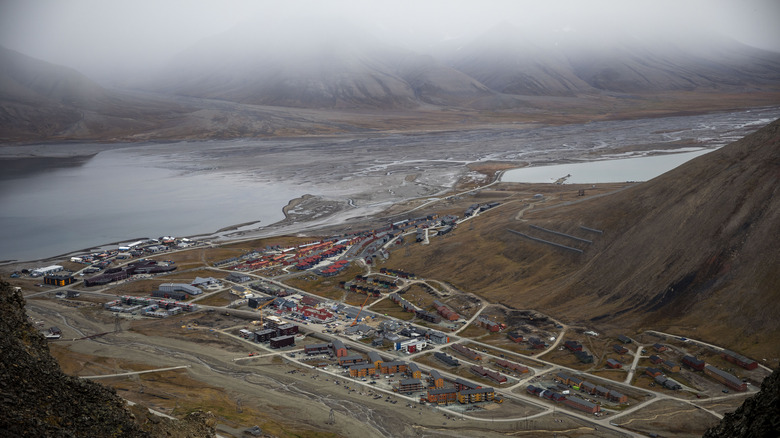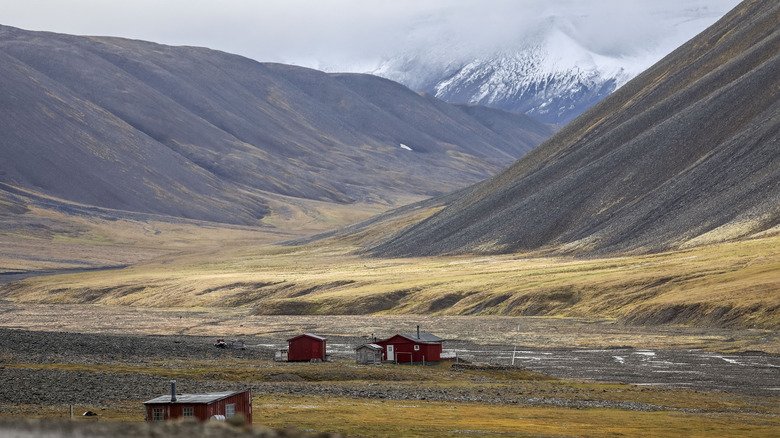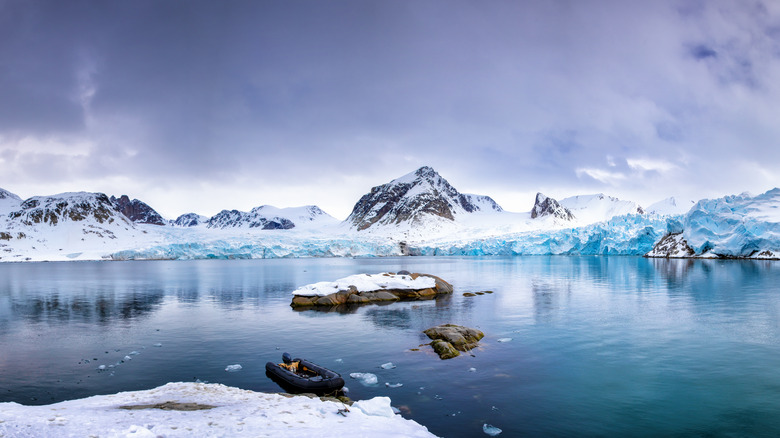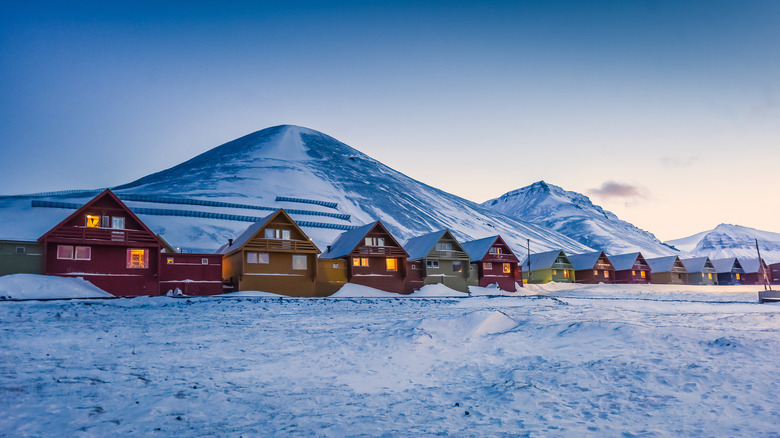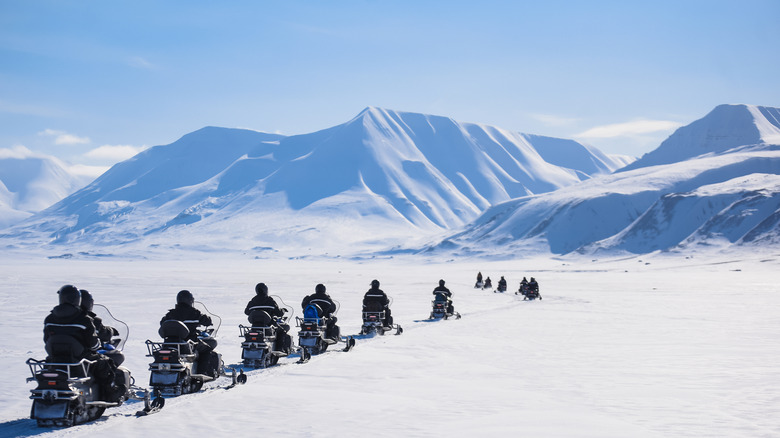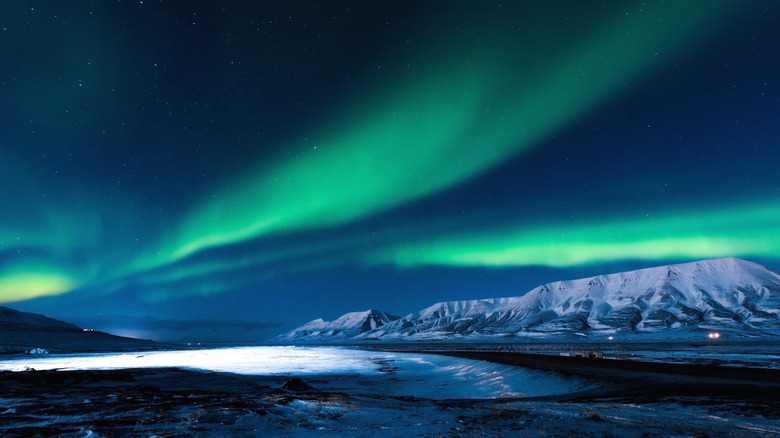Inside Svalbard, Norway, The World's Northernmost Inhabited Region
It's safe to say that most folks are driven toward comfort, if not obsessed with it: chair backs inclined at optimal angles, bellies pleasantly full, and bodies swaddled in the embrace of central heating. The unparalleled cushiness of modernity would leave all of our hunter-forager, tooth-and-nail-scrabbling ancestors crying, "You're all a bunch of candy-a****." That being said, some people still hear and obey the call of adversity. They scale mountainsides, strain the limits of endurance in marathons, or at least refuse extra-large French fries with their double cheeseburgers. Other folks go one step further and move to Norway.
The town of Longyearbyen on the island of Spitsbergen in Svalbard, Norway, is the northernmost human settlement on Earth. The Svalbard archipelago is located about 575 miles north of Norway's northernmost city, Tromsø, and only 685 miles south of the North Pole (per Climates to Travel and The Atlantic, respectively). At a latitude of 74 to 80 degrees, Svalbard's hottest annual temperature reaches only about 6.7 degrees Celsius in July (44 Fahrenheit).
To Longyearbyen's 2,400 permanent residents, their life is as normal as anyone else's. They work, go to school, eat, drink, and carry on the same as anyone, anywhere. They also carry firearms outside in case of polar bears, watch ocean-breaching whales through their windows, and use separate snowmobile roads through their one-grocery-store downtown (via Visit Svalbard). Svalbard is not only a testament to the human spirit but also the ability to make adversity an ally.
A legacy of Viking hardiness
Norway and Scandinavia on a whole (Norway, Denmark, Sweden) are no strangers to harsh living conditions. After all, look at who this region sired: the Vikings. During the Viking Age (about 800-1050 C.E., per the National Museum of Denmark), those seafaring raider-trader-marauders traveled and migrated practically everywhere: east through Finland and Russia, down to the Baltic Sea, through western Europe, up through the United Kingdom and Scotland, and even out to Iceland, Greenland, and North America. And trust us, they weren't the kind to grumble about non-optimal temperatures and poorly inclined desk chairs.
As Visit Svalbard (Svalbard's official tourism board) says, the first mention of the region dates back to 1194 C.E. in the Icelandic sagas, a collection of over 40 historical accounts of Scandinavian Vikings, Icelandic farmers, and Norwegian kings. The word "Svalbardi" literally means "the land with the cold shores." It's uncertain whether this mention refers to modern-day Svalbard (Vikings weren't big on paper records), but as the University of Calgary points out, there's at least evidence that the Vikings were poking around in the region during that time. After all, Svalbard is smack dab between Iceland and Greenland, albeit a bit north of both. This makes it an ideal stop on ocean journeys, even if it's accidentally discovered.
The first official discovery of Svalbard goes back to 1596 by Dutch explorer Willem Barentsz. After that, it became a hotspot for fishing, trapping, mining, and exploratory expeditions. Only in 1906 was Longyearbyen permanently settled.
Stark, visa-free beauty
To be fair, it's not too tough to see the appeal of at least visiting Svalbard, if not living there. Svalbard's starkly gorgeous landscape is like a vision of pre-humanity Earth full of glaciers, tough grasslands, jagged mountain peaks, and unafraid wildlife. In winter months, the green-banded aurora borealis streaks the sky more often than not. From April 20 to August 22, Longyearbyen's multi-hued cabins reflect the perpetual, never-setting midnight sun (via Visit Norway). The region is remote, self-contained, and has its own airport, but it hosts more tourists than you'd expect, often via cruises on sites like Seabourn and Quark Expeditions.
Svalbard also houses the Svalbard Global Seed Vault, a safety-deposit box protecting the source of all food — seeds — from impending climatological catastrophes. At present, the vault holds 177,850 seed samples from 12 species, as the Norwegian Government Security and Service Organisation website reports. Every facet of Longyearbyen, in fact, is built with ecology in mind. For a region so closely connected to and dependent on nature's harsher face, this makes complete sense.
As the BBC says, 46 nations signed a treaty in 1920 declaring Norway's sovereignty over Svalbard. However, Svalbard's unique political position means that it's a "visa-free zone," as Live in Norway explains. Anyone can move there from anywhere and stay as long as they like (provided they can support themselves). At present, Svalbard's 2,900 hardy inhabitants are composed of people from over 50 countries.
A single shopping street for daily life
So what does daily life on Svalbard look like? What do people do for work? What do they eat? What do they do for fun? Are things expensive? Norwegian national and 5+-year Longyearbyen resident Cecilia Blomdahl provides insight into these kinds of questions on her very thorough YouTube channel.
On a whole, as Visit Svalbard describes, folks often stay on Svalbard longer than they originally expected. "I only planned to be here for one year, but I've been here for many years now" is a common comment, with 7 years being the average length of stay. Longyearbyen, Svalbard's town, is the most common place to live on the archipelago and contains 2,400 of the island's 2,900 inhabitants. This means some 500 people hunker down in scattered cabins across the ice-and-wind-torn expanse of glaciers and rock. And yes, there are more polar bears than people on Svalbard (about 3,000 bears, all of which are protected from harm by law).
Svalbard itself is split into sets of apartments close to the town center and individual cabins further away on the coasts of fjords. Most folks live in the apartments, but some rent the cabins as a second home. As Bomdhal shows us on YouTube, the town center is just a single strip of road that contains a café, pharmacy, shopping center, supermarket, a bunch of outdoor goods and sporting goods shops, a couple of restaurants, some hotels, a tourist center, and some business centers.
Outdoor fun and high food costs
Longyearbyen began as a soot-covered coal-mining town, so to this day, going inside means taking off your boots. Crime isn't really an issue, though. At most, drunk people sometimes grab other people's shoes by accident on their way outside, as Longyearbyen resident Cecilia Blomdahl explains on YouTube. On a whole, people typically work in manufacturing, are self-employed in local small businesses, or work remotely.
Not surprisingly, most folks take to the outdoors for fun. Snowmobile riding across the snowy landscape, hiking, and cooking at campfires with friends rank high on the list of downtime activities. Most folks have snowmobiles rather than cars. Otherwise, it's impossible to explore outside of Svalbard's small networks of roads and Longyearbyen's tiny town proper, as Blomdahl again describes on YouTube. Wired for Adventure estimates that there are about 4,000 snowmobiles in Longyearbyen, compared to 2,400 residents.
Monthly costs aren't impossibly expensive, but probably higher than expected. Per Blomdhal's personal monthly breakdown on YouTube, food is the biggest cost at $1,200 a month for two people. Considering the shipping costs all the way to Earth's northernmost inhabited island, this makes sense. Electricity and heat together also run pretty high at about $500 together per month (in a cabin, not an apartment). Rent is comparatively cheap, though, but no one can own land. You can build on it and own what you build, but the government owns the land itself. Sales tax is 16% (via Spitsbergen), and health insurance is completely free.
Extremes of temperature and light
Svalbard's visa-free status is attractive to people for a host of reasons. Longyearbyen resident Cecilia Blomdahl describes on YouTube how her nail stylist, for instance, fled to Svalbard eight years ago from Ukraine during armed conflicts with Russia. Now, the stylist runs a mini-salon out of her apartment and has fully integrated into the local community, Norwegian language and all. There's also a high number of Thai ex-pats, so the city even contains some signage in Thai.
There are plenty of other pros and cons to living in Svalbard. There's no maternity ward on the island, as the BBC explains, and the local government requires the deceased to be shipped back to mainland Norway because the permafrost disallows burials. In the winter, cold reaches -25 to -30 degrees Celsius (-13 to -22 Fahrenheit), which still might be easier to deal with than Svalbard's months of sustained darkness (via Climates to Travel). As Smithsonian Magazine outlines, lack of sunlight can have profound physical and psychological repercussions, ranging from rickets and tuberculosis to depression and seasonal affective disorder (SAD). And for the record, pushing around a baby carriage with a rifle strapped to your back might be an extreme pro or con, depending on your perspective.
Most challenging in the future, though, will be climate change. As Scientific American describes, Svalbard is among the fastest-warming places on Earth because of its extreme latitude. Each year also sees more and more tourists, which can interfere with the natural environment.
